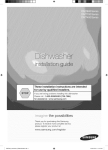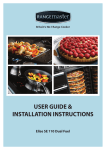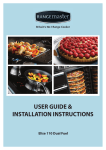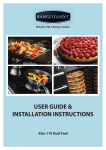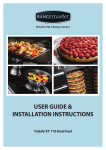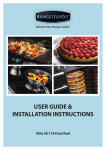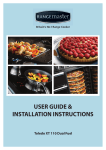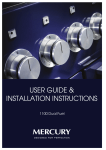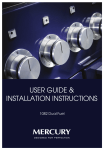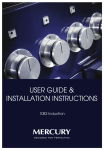Download Rangemaster Toledo FS Hob User guide
Transcript
Britain’s No.1 Range Cooker USER GUIDE & INSTALLATION INSTRUCTIONS Toledo FS Hob RANGEMASTER COOKWARE Our range cookers are well known for providing the best possible cooking performance and years of faithful service. However, a great cooker alone cannot guarantee perfect results every time. The other vital ingredients are of course enthusiasm and quality cookware. We offer cookware to work perfectly with all fuel types manufactured by Rangemaster, including induction hobs. You can be assured of functionality with style, as well as the quality and meticulous attention to detail you expect from the pioneers of range cooking. Visit: www.rangemastercookshop.co.uk FRUITY BAKED PUDDING Serves 4–6 Ingredients Method • • • • • • 1. Preheat the oven to 200 °C (for a conventional oven), 180 oC (for a fan oven) or gas mark 6. • • • • • • • Oil for greasing 100 g strawberries 100 g raspberries 100 g redcurrants 100 g blackberries or a 400 g mixture of any soft fruits 2 medium eggs 30 g caster sugar 80 ml skimmed milk 2 tsp vanilla extract 60 g plain flour (sifted) 1 tsp baking powder Icing sugar to dust 2. Lightly grease a dish 26 cm wide x 4 cm deep. 3. Thickly slice any large strawberries and place them with the other fruits into an ovenproof dish, deep enough so the berries are about 2 deep. 4. Whisk the eggs and caster sugar until pale and fluffy. Beat the milk and vanilla extract into the mixture and then fold in the sifted flour and baking powder. 5. Pour the cake mix over the fruit and bake on the centre shelf of the oven for 15-20 minutes, or until the mixture is cooked through and golden on the top. 6. Dust with icing sugar and serve immediately with cream or crème fraiche. ROAST LOIN OF PORK WITH PROSCUITTO & BAY LEAVES Ingredients Method • 3 kg (6½ lb) skinned and boned loin of pork • 2 x 70 g packs prosciutto • Grated zest of 2 lemons • Bay leaves • Salt and freshly ground black pepper 1. Preheat the oven to 220 °C (for a conventional oven), 200 °C (for a fan oven) or gas mark 7. For the sauce: • 1 tablespoons plain flour • 4 tablespoons lemon juice • Chicken stock/water 2. Spread one of the packs of prosciutto over a chopping board; place the pork on top with the outer (fat) part of the pork resting on the prosciutto. 3. Sprinkle the lemon zest onto the inside of the meat and season well. Lay the remaining prosciutto on top of the zest and roll up. 4. Secure the pork with string or silicone bands and thread bay leaves under the string, covering the whole piece of pork. Put the meat on to a trivet over a large roasting tin containing enough water to cover the base. 5. Place into the oven and cook for 30 minutes. Reduce the heat to 180 °C conventional oven/160 °C fan oven/gas 4 and continue roasting for a further 25 minutes per 500 g. Should the prosciutto start becoming too brown, cover with some foil. 6. When the pork is cooked, place onto a warm plate, cover with foil and allow to rest for at least 20 minutes. 7. Spoon off most of the fat from the roasting tin and stir the flour into the remaining. Gradually add the stock and lemon juice, adding more stock until the desired consistency is reached and simmer for 5 minutes. Check the seasoning, adding more pepper or lemon juice as necessary. 8. Remove the string or bands from the pork and carve into slices, serve with the sauce. Contents 1. 2. 3. 4. Before You Start... 1 5. Installation 9 Important! 1 Dear Installer 9 Installation and Maintenance 1 Safety Requirements and Regulations 9 Peculiar Smells 1 Provision of Ventilation 9 If You Smell Gas 1 Location of the Hob 10 Ventilation 1 Conversion 10 Personal Safety 1 Positioning the Hob 11 Cleaning 1 Conversion to LP Gas 11 Hob Overview 2 Gas Connection 12 Hotplate Burners 2 Pressure Testing 13 Wok Burner 3 Fixing the Hob 13 The Wok Cradle (optional) 4 Electrical Connection 14 The Griddle (optional) 4 Final Checks 14 Warmer 5 Customer Care 14 Cleaning Your Cooker Essential Information 6 Hotplate Burners 6 The Griddle 6 Cleaning Table 7 Troubleshooting Toledo FS Hob 6. 6 8 i Conversion to LP Gas 15 Injectors 15 Tap Adjustment 15 Stick on Label 15 Pressure Testing 16 7. Circuit Diagram 17 8. Technical Data 18 U108900-09 ii 1. Before You Start... Personal Safety Your hob should give you many years of trouble-free cooking if installed and operated correctly. It is important that you read this section before you start, particularly if you have not used a gas hob before. DO NOT modify this appliance. nn This appliance is not intended for use by persons nn (including children) with reduced physical, sensory Important! or mental capabilities, or lack of experience and knowledge, unless they have been given supervision or instruction concerning use of the appliance by a person responsible for their safety. This appliance is designed for domestic cooking only. Using it for any other purpose could invalidate any warranty or liability claim. In particular, the oven should NOT be used for heating the kitchen – besides invalidating claims this wastes fuel and may overheat the control knobs. This appliance is not intended for use by young nn children or infirm persons unless they have been This appliance is for use in Great Britain and the Republic of Ireland. It is a Cat II2H3+ hob and is set for G20 at 20 mbar. (A conversion kit for LPG is supplied with the hob). CAUTION: A long term cooking process has to be nn supervised from time to time. A short term cooking nn adequately supervised by a responsible person to make sure that they can use the appliance safely. nn process has to be supervised continuously. Installation and Maintenance Danger of fire: DO NOT store items on the cooking nn surfaces. In the UK, this appliance must be installed by a Gas Safe registered engineer. The electrical installation should be in accordance with BS 7671. Otherwise, all installations must be in accordance with the relevant instructions in this booklet, with the relevant national and local regulations, and with the local gas and electricity supply companies’ requirements. DO NOT use hotplate protectors, foil or hotplate nn covers of any description. These may affect the safe use of your hotplate burners and are potentially hazardous to health. Accessible parts will become hot during use and will nn retain heat even after you have stopped cooking. Make sure that the gas supply is turned on and that the hob is wired in and switched on (the hob needs electricity). Only a qualified service engineer should service the hob, and only approved spare parts should be used. Always allow the hob to cool and then switch it off at the mains before cleaning or carrying out any maintenance work, unless specified otherwise in this guide. Keep babies and children away from the hob and never wear loose-fitting or hanging clothes when using the appliance. Always be certain that the controls are in the OFF nn position when the hob is not in use, and before attempting to clean the hob. Peculiar Smells DO NOT use a steam cleaner on your hob. nn NEVER operate the cooker with wet hands. nn NEVER heat unopened food containers. Pressure build nn up may make the containers burst and cause injury. When you first use your hob it may give off an odour. This should stop after use. If You Smell Gas • DO NOT turn electric switches on or off • DO NOT smoke • DO NOT use naked flames • DO turn off the gas at the meter or cylinder • DO open doors and windows to get rid of the gas • DO keep people away from the area affected • Call your gas supplier If you are using natural gas in the UK, ring the National Grid on: 0800 111 999. Take care NOT to place metallic objects such as nn knives, forks, spoons and lids on the hob surface since they can get hot. The appliance is not intended to be operated by nn means of external timer or separated remote-control system. Take care that no water seeps into the appliance. Cleaning In the interests of hygiene and safety, the hob should be kept clean at all times as a build up in fats and other foodstuff could result in a fire. Ventilation The use of a gas cooking appliance results in the production of heat and moisture in the room in which it is installed. Therefore, make sure that the kitchen is well ventilated: keep natural ventilation holes open or install a powered cooker hood that vents outside. If you have several burners on, or use the cooker for a long time, open a window or turn on an extractor fan. Clean only the parts listed in this guide. Clean with caution. If a wet sponge or cloth is used to wipe spills on a hot surface, be careful to avoid steam burns. Some cleaners can produce noxious fumes if applied to a hot surface. 1 2. Hob Overview DocAUS.020-0004 - Overview - 110DF - Elan Fig.2-1 C B A The Toledo FS hob (Fig.2-1) has the following features: Fig.2-2 A. B. C. 5 hotplate burners including a wok burner A control panel A warmer plate Hotplate Burners The drawing by each of the central knobs indicates which burner that knob controls. Each burner has a Flame Supervision Device (FSD) that prevents the flow of gas if the flame goes out. When the igniter button is pressed in, sparks will be made at every burner – this is normal. Do not attempt to disassemble or clean around any burner while another burner is on, otherwise an electric shock could result. Fig.2-3 To light a burner, push in and turn the associated control knob to the high position as indicated by the large flame symbol (), (Fig.2-2). The igniter should spark and light the gas. Keep holding the knob pressed in to let the gas through to the burner for about ten seconds. If, when you let go of the control knob, the burner goes out, then the FSD has not been bypassed. Turn the control knob to the OFF position and wait for one minute before you try again, this time making sure to hold in the control knob for slightly longer. Adjust the flame height to suit by turning the knob clockwise (Fig.2-3). If a burner flame goes out, turn off the control knob and leave it for one minute before relighting it. 2 Make sure that the flames are under the pans. Using a lid will help the contents boil more quickly (Fig.2-4). Fig.2-4 Large pans should be spaced well apart. Pans and kettles with concave bases or down-turned base rims should not be used (Fig.2-5). Simmering aids, such as asbestos or mesh mats, are NOT recommended (Fig.2-6). They will reduce burner performance and could damage the pan supports. ArtNo.311-0001 Right pans gas You should also avoid using unstable and misshapen pans that may tilt easily, and pans with a very small base diameter, e.g. milk pans, single egg poachers (Fig.2-7). Fig.2-5 The minimum recommended pan diameter is 120 mm. The maximum allowable pan base diameter is 260 mm. ArtNo.311-0002 Pan with rim DO NOT use cooking vessels on the hotplate that overlap the edges. Wok Burner Fig.2-6 The wok burner is designed to provide even heat over a large area. It is ideal for large pans and stir-frying (Fig.2-8). For heating smaller pans, the aforementioned hotplate burners may be more efficient. Note on enamel hobs: You should wipe the enamel top surface of the cooker around the hotplate burners as soon as possible after spills occur. Try to wipe them off while the enamel is still warm. Art No. 311-0003 Simmer aids Fig.2-7 Note: The use of aluminium pans may cause metallic marking of the pan supports. This does not affect the durability of the enamel and may be cleaned off with an appropriate metal cleaner. ArtNo.311-0004 Tipping wok Fig.2-8 3 The Wok Cradle (optional) Fig.2-9 The wok cradle is designed to fit a Professional 35 cm Wok. If you use a different wok, make sure that it fits the cradle. Woks vary very widely in size and shape. It is important that the wok sits down on the pan support – however, if the wok is too small, the cradle will not support it properly (Fig.2-9). The cradle should be used on the wok burner only. When you fit the cradle, check that it is properly located on the pan support and that the wok is sitting level in the cradle (Fig.2-10). ArtNo.311-0006 Correct wok sizes Fig.2-10 The cradle will get very hot in use – allow plenty of time for it to cool before you pick it up. The Griddle (optional) The griddle fits the centre right-hand pan support, front to back (Fig.2-11). It is designed for cooking food on directly. DO NOT use pans of any kind on it. The griddle surface is nonstick and metal cooking utensils (e.g. spatulas) will damage the surface. Use heat resistant plastic or wooden utensils. ArtNo.311-0007 Wok stand close-up Fig.2-11 DO NOT put it crossways – it will not fit properly and nn will be unstable (Fig.2-12). DO NOT put it on any other burner – it is not nn designed to fit in any of the other pan supports. Position the griddle over the hotplate burners resting on the pan support. Check that it is securely located. The griddle can be lightly brushed with cooking oil before use (Fig.2-13). Light the hotplate burners. Adjust the flame heights to suit. Preheat the griddle for a maximum of 5 minutes before adding food. Leaving it longer may cause damage. Turn the control knobs towards the low position, marked with the small flame symbol, to reduce the burner flames. Fig.2-12 Always leave space around the griddle for the gases nn to escape. NEVER fit two griddles side by side (Fig.2-14). nn After cooking, allow the griddle to cool before cleaning. Fig.2-13 ArtNo.311-0009 Oil on griddle Fig.2-14 ArtNo.311-0008 Griddle positioning 4 Warmer Warmer On the right of the hob is the Warmer (Fig.2-15). Use the Warmer for keeping food warm while the final touches are put to a meal. Fig.2-15 To switch on the Warmer, turn the control knob either clockwise or counter-clockwise – the HOT indicator lights up. For best results, preheat a covered serving dish for 10 minutes before adding food to it. Use only heat resistant dishes. Warmer control CAUTION: If the warmer/control panel glass shatters due to accidental damage, etc. then immediately isolate the hob from the electricity supply by switching it off at the wall and arrange for its repair. DO NOT reconnect the hob to the electrical supply nn until after repair. 5 3. Cleaning Your Cooker Essential Information Fig.3-1 A Isolate the electricity supply before carrying out any thorough cleaning. Allow the cooker to cool. C NEVER use paint solvents, washing soda, caustic nn cleaners, biological powders, bleach, chlorine based B bleach cleaners, coarse abrasives or salt. DO NOT mix different cleaning products – they may nn react together with hazardous results. E D All parts of the cooker can be cleaned with hot soapy water – but take care that no surplus water seeps into the appliance. ArtNo.311-0032 Burner layout FSD A – Cap, B – Head, C – Notch, D – Base, E – Electrode Remember to switch on the electricity supply before re-using the hob. Fig.3-2 A Hotplate Burners The burner heads and caps can be removed for cleaning. Make sure they are absolutely dry before replacing them. B DO NOT put the burner heads in a dishwasher. nn C The Single Ring Burners When refitting the burner head, make sure that the notch lines up with the electrode or hole in the base. Check that the burner head is level and that the cap is fitted centrally on the burner head (Fig.3-1). D ArtNo.311-0033 Wok burner details FSD The Wok Burner The wok burner can also be taken apart for cleaning. E When reassembling the wok burner (Fig.3-2), turn over the large base ring and find the ‘D’ shaped area (Fig.3-3). Turn the head until the ‘D’ matches the one on the burner base. Flip the burner over once again and place it on the burner base. A – Inner burner cap, B – Outer burner cap, C – Inner burner head, D – Outer burner head, E – Wok burner base To fit the small inner burner, find the larger electrode notch in the burner rim. Line this up with the white ignition electrode and place the inner burner on the large base ring (Fig.3-4). Fig.3-3 Now fit the two burner caps, making sure that they are seated properly. Check the burner ports are not blocked. If a blockage occurs, remove stubborn particles using a piece of fuse wire. The Wok Cradle Fig.3-4 Recommended cleaning materials are hot soapy water, a moistened soap pad, cream cleaner or a nylon scourer. B The Griddle Always clean the griddle after use. Allow it to cool completely before removing. Immerse the griddle plate in hot soapy water. Use a soft cloth or, for stubborn stains, a nylon washing up brush. Alternatively, the griddle can be washed is a dshwasher. A Note: If the griddle is washed in a dishwasher then some dishwasher residue may appear on the back. This is normal and will not affect the performance of your griddle. ArtNo.311-0016 Fitting the burner inner head A – Electrode notch, B – Ignition electrode 6 Cleaning Table Cleaners listed (Table 3-1) are available from supermarkets or electrical retailers as stated. For enamelled surfaces use a cleaner that is approved for use on vitreous enamel. Regular cleaning is recommended. For easier cleaning, wipe up any spillages immediately. Hotplate Part Finish Recommended Cleaning Method Hob top Enamel or stainless steel Hot soapy water, soft cloth. Any stubborn stains remove gently with a nylon scourer. Ceramic/Induction hob Toughened glass Hot soapy water; cream cleaner/scourer if necessary. Griddle plate (some models only) Non-stick surface Allow to cool. Wash in hot soapy water. Do not use abrasive cleaners/scourers. Dishwasher. Warming zone (some models only) Toughened glass Hot soapy water, cream cleaner/scourer if necessary. Outside of Cooker Part Finish Recommended Cleaning Method Enamel or paint Hot soapy water, soft cloth. Any stubborn stains, remove gently with a liquid detergent. Stainless steel E-cloth (electrical retailers) or microfibre all-purpose cloth (supermarket). Sides and plinth Painted surface Hot soapy water, soft cloth. Splashback/rear grille Enamel or stainless steel Hot soapy water, soft cloth. Cream cleaner, with care, if necessary. Control panel Paint, enamel or stainless steel Warm soapy water. Do not use abrasive cleaners on lettering. Control knobs/handles & trims Plastic/chrome, copper or lacquered brass Warm soapy water, soft cloth. Brass Brass polish. Toughened glass Hot soapy water, cream cleaner/scourer if necessary. Finish Recommended Cleaning Method Door, door surround and storage drawer exterior Oven door glass/glass lid Oven and Grill Part Any proprietary oven cleaner that is suitable for enamel. Sides, floor & roof of oven NOT COOK & CLEAN OVEN PANELS (see Enamel below) CAUTION: CORROSIVE/CAUSTIC OVEN CLEANERS: FOLLOW MANUFACTURER’S INSTRUCTIONS. Do not allow contact with the oven elements. Cook & Clean oven panels (some models only) Special enamel that partly cleans itself This surface cleans itself at 200°C and above, or the panels can be removed and washed with hot soapy water and a nylon brush (see ‘The Ovens’ in ‘Cleaning Your Cooker’). Oven shelves, Handyrack, Grill trivet, Handygrill rack (some models only) Chrome An oven interior cleaner that is suitable for chrome. Soap filled pad. Dishwasher. Grill pan/meat tin (some models only) Enamel Hot soapy water. Soap filled pad. Dishwasher. Table 3-1 7 4. Troubleshooting Hotplate ignition or hotplate burners faulty Is the power on? What cleaning materials are recommended for the cooker? See the ‘Cleaning’ section for recommended cleaning materials. If not, there maybe something wrong with the power supply. Never use caustic or abrasive cleaners as these will nn damage the surface. Are the sparker (ignition electrode) or burner slots blocked by debris? If there is an installation problem and I don’t get my original installer to come back to fix it who pays? You do. Service organizations will charge for their call outs if they are correcting work carried out by your original installer. It is in your interest to track down your original installer. Are the burner trim and caps correctly located? See the section on ‘Cleaning’. Hotplate burners will not light Make sure that the burner parts have been replaced correctly after wiping or removing for cleaning. Check that there is not a problem with your gas supply. You can do this by making sure that other gas appliances you may have are working. Do the burners spark when you push the button? If not, verify that the power is on. 8 INSTALLATION Check the appliance is electrically safe and gas sound when you have finished. 5. Installation Dear Installer In the UK the hob must be installed in accordance with: Before you start your installation, please complete the details below, so that, if your customer has a problem relating to your installation, they will be able to contact you easily. • • • Installer’s Name Installer’s Company • • All relevant British Standards / Codes of Practice, in particular BS 5440 Part 2. For Natural Gas – BS 6172 and BS 6891. For LP Gas – BS 5482-1 (when the installation is in a permanent dwelling), BS 5482-2 (when the installation is in a caravan or other non- permanent dwelling) or BS 5482-3 (when the installation is in a boat). The Gas Safety (Installation and Use) regulations. The relevant Building / IEE regulations. In the Republic of Ireland the hob must be installed in accordance with: ArtNo.050-0011 - Installer information table Installer’s Telephone Number The installation must be carried out by a competent person and installed in accordance with the current edition of IS 813 “Domestic Gas Installations”, the current Building Regulations and reference should be made to the current ETCI rules for electrical installation. Appliance Serial Number Provision of Ventilation This appliance is not connected to a combustion products evacuation device. Particular attention shall be given to the relevant requirements regarding ventilation. Safety Requirements and Regulations All rooms require a window that can be opened, or equivalent, while some rooms require a permanent vent in addition to the window. In your own interest and that of safety, it is law that all gas appliances be installed by competent persons. Gas Safe registered installers undertake to work to safe and satisfactory standards. Failure to install the appliance correctly could invalidate any warranty or liability claims and lead to prosecution. nn In the UK The room containing the hob should have an air supply in accordance with BS 5440 Part 2. All rooms require an openable window or equivalent, while some rooms require a permanent vent in addition to the openable window. The hob should not be installed in a bedsitting room with volume less than 20 m³. If it is installed in a room of volume less than 5 m³ an air vent of effective area 100 cm² is required; if it is installed in a room of volume between 5 m³ and 10 m³, an air vent of effective area 50 cm² is required; while if the volume exceeds 11 m³, no air vent is required. This hob must be installed in accordance with nn the relevant instructions in this booklet, with the relevant national and local regulations, and with the local gas and electricity supply companies’ requirements. This hob is a Class 3 appliance. nn Before installation, make sure that the hob is nn suitable for your gas type and supply voltage. See If there are other fuel burning appliances in the same room, BS 5440 Part 2 should be consulted to determine the requisite air vent requirements. the data badge. The appliance must be installed in accordance with nn the regulations in force and only in a well ventilated In the Republic of Ireland space. Reference should be made to the current edition of IS 813, which makes clear the conditions that must be met to demonstrate that sufficient ventilation is available. Read the instructions before installing or using this nn appliance. This appliance can be converted for use on another nn gas. 9 INSTALLATION Check the appliance is electrically safe and gas sound when you have finished. Checking the Parts: Location of the Hob The hob may be installed in a kitchen/kitchen diner but NOT in a room containing a bath or shower. 3 pan supports This appliance is designed for domestic cooking only. Use for any other purpose could invalidate any warranty or liability claim. Note: An appliance for use on LPG must not be installed in a room or internal space below ground level, e.g. in a basement. Conversion This appliance is supplied set for G20 20 mbar Cat II2H3+. A conversion kit for another gas is included with the hob. If the appliance is to be converted to another gas we recommend that this is carried out before installation. See the instructions that are supplied with the conversion kit. After converting the appliance, please attach the Gas Conversion sticker over the appropriate area of the data badge – this will identify the gas type for which the appliance is now set. You will need the following equipment to complete the hob installation satisfactorily: • • • Gas pressure tester/manometer. Flexible gas hose: Must be in accordance with the relevant standards. Multimeter: For electrical checks. You will also need the following tools: 1. Electric drill 2. Jigsaw 3. Steel tape measure 4. Cross head screwdriver 5. Flat head screwdriver 6. Spirit level 7. Pencil 8. Adjustable spanner 9. 4 mm & 3 mm Allen keys 10 INSTALLATION Check the appliance is electrically safe and gas sound when you have finished. Positioning the Hob Cut-out Fit the hob into a worksurface which is at least 600 mm deep. Fig.5-1 Worktop You can fit the hob to worktops of between 30 mm and 50 mm thick. For example: If fitting to a 30 mm worktop, the base of the hob extends below the worktop by up to 20 mm. Make sure that there is sufficient clearance below the hob to avoid interference with drawer bodies, support struts, etc. 600 mm minimum 468 mm 1150 mm The cut-out should be positioned centrally so that the spaces at the front and rear are equal. Fig.5-1 shows the required cut-out. Fig.5-2 Fig.5-2 shows the minimum recommended distances from the hob to nearby surfaces. Above hotplate level a gap of 75 mm should be left between the left-hand side of the hotplate and any adjacent vertical surface. 650 mm minimum For non-combustible surfaces (such as unpainted metal or ceramic tiles) this can be reduced to 25 mm. 75 mm min A minimum space of 650 mm is required between the top of the hotplate and a horizontal combustible surface. *Any cookerhood should be installed in accordance with the hood manufacturer’s instructions. **Any splashback must be fitted in accordance with the manufacturers instructions. Allowance should be made for the additional height of the flue trim, which is fitted to the cooker hob. Fig.5-3 1100mm* min 410mm min Surfaces of furniture and walls at the sides and rear of the hotplate should be heat, splash and steam resistant. Certain types of vinyl or laminate kitchen furniture are particularly prone to heat damage and discolouration. We cannot accept responsibility for damage caused by normal use of the hotplate to any material that de-laminates or discolours at temperatures less than 65 °C above room temperature. Worktop For safety reasons curtains MUST NOT be fitted immediately behind the hotplate. Wall nn Note: When the Toledo FS ovens are situated under the hob, additional brackets should be fixed to the rear wall to support the rear edge of the worktop. Two right-angle brackets are supplied for this purpose. Alternatively, a wooden baton could be fixed to the wall under the rear edge. Oven front top supports the hotplate The front edge will be supported by the ovens once they are in place. It is important that the hob is placed directly above the ovens to ensure this (Fig.5-4). Hob Bracket at rear fixed to wall Ovens Moving the Hob The hob is heavy. Take great care. nn We recommend two people move the hob. Conversion to LP Gas If the appliance is to be converted to LP gas do the conversion at this point. See the ‘Conversion to LP Gas’ section of these instructions. 11 Fig.5-4 INSTALLATION Check the appliance is electrically safe and gas sound when you have finished. Fig.5-5 Gas Connection Front Before connecting the hob, check that it is suitable for your gas and electricity supply. This information is on the data label fixed to the underside of the hob. Gas connection must comply with the relevant standards and regulations in force. The gas connection point is located as shown (Fig.5-5). The inlet union is Rp ½. Underside of hob The appliance must be connected to the gas supply system with one of the following: A – Rigid Steel Pipe Wall The joints of this pipe must consist of threaded fittings conforming to the standards. Use of seals such as hemp with suitable cement, or Teflon tape, is permitted. Gas connection B – Copper Pipe The joints of this pipe must consist of unions with mechanical seals. C – Flexible Hose A hose is not supplied by with the hob. Hoses may be purchased at most builders’ merchants. The hose should be fitted so that both inlet and outlet connections are vertical so that the hose hangs downwards. The hose must be in accordance with the relevant standards. In the UK these are: • • • • For Natural Gas the flexible hose must be in accordance with BS 669. For LP Gas it should be capable of 50 mbar pressure, 70 °C temperature rise and carry a red stripe, band or label. Make sure that the gas supply pipe is never able to touch moveable parts of the built-in cabinet (e.g. drawers). It must not pass through compartments that could be used for storage purposes. When using a flexible hose, it is essential to comply with the following instructions: • • • • • No part of the pipe must be able to touch parts the temperature of which exceeds 75 °C. The pipe must not be pulled or twisted, throttled or tightly bent. It must not come into contact with sharp edges or corners. It must be easy to inspect the entire pipe length in order to check its state of wear. The pipe must be replaced within the date stamped on the pipe itself. If in doubt contact, your supplier. After completing the gas connection, check the hob is gas sound with a pressure test. 12 INSTALLATION Check the appliance is electrically safe and gas sound when you have finished. Pressure Testing Fig.5-6 The gas pressure can be measured at one of the hotplate burner injectors (not the wok burner). Lift off a burner head. Fit the pressure gauge to the injector. Turn on and light one of the other hotplate burners. Turn on the control knob for the burner with the pressure gauge fitted to let gas through. See the data badge for test pressures. Turn off the burners. Make sure that you reassemble the burner top in the correct way on the burner body. Fixing the Hob The hob must be sealed to the worksurface to prevent liquid from infiltrating into the cabinet. A foam tape seal is supplied with the hob. Fig.5-7 Fit the seal as follows: 1. 2. 3. 4. 5. Turn the hob over and place on a secure level surface. Detach the foam seal from the backing, checking that the transparent protection still adheres to the seal itself. Position the seal carefully along the edge of the hob. Take special care in the corners, making sure there are no gaps (Fig.5-6). The ends of the strips must fit together without overlapping. If the surface that the hob is to be fitted to is tiled or is not reasonably smooth, additional sealing with a waterproof silicone sealant may be required. Turn the hob back the right way up and position it within the worktop cut-out. Using the brackets supplied, fix the hob to the worktop. Make sure the tag fits into the slot on the hob base (Fig.5-7), then tighten the screw until it is locked to the worktop. 13 INSTALLATION Check the appliance is electrically safe and gas sound when you have finished. Fig.5-8 Earth Electrical Connection Live The hob must be installed by a qualified electrician, in accordance with all relevant British Standards/Codes of Practice (in particular BS 7671), or with the relevant national and local regulations. WARNING: THIS APPLIANCE MUST BE EARTHED nn Cable clamp Fig.5-9 Neutral: to the terminal marked N, coloured Blue All external wiring must comply with the IEE Regulations for the Electrical Equipment of Buildings. Connection to the electrical supply can be made with either a plug and socket or be permanently wired via a double pole switch. The hob is supplied with a 3-core cable 2 m long. Neutral Earth: to the terminal marked E, coloured Green/Yellow If a replacement cable is fitted it must be 250 V high temperature PVC (85 °C), 1 mm² and connected to the terminal block as shown (Fig.5-8). Should the plug not fit the socket in your home, it should be removed and replaced with a suitable plug. Live: to the terminal marked L, coloured Brown Note: If the plug is fitted is not suitable, it must be cut off and disposed of properly. To avoid the risk of electrocution, the plug must not be left where children might find it and plug it into a supply socket. Three pin plugs to BS 1363 with a capacity of not less than 13 A must be used and fitted with a 13 amp fuse ‘ASTA’ approved to BS 1362. You MUST refit the cover after replacing the fuse. If the cover is lost, the plug MUST NOT be used until a replacement cover has been obtained from your supplier. The colour of the correct fuse carrier is that of the coloured insert in the base of the fuse recess, or stated elsewhere on the plug. Always state this colour when ordering a replacement fuse carrier. IMPORTANT: The wires in the mains lead are coloured in accordance with the following code (Fig.5-9): Green and yellow: EARTH Blue: NEUTRAL Brown: LIVE Final Checks Hotplate Check Check each burner in turn (refer to the ‘Hotplate Burners’ section at the front of the instructions). Customer Care Installer: Please complete your details in this guide, inform the user how to operate the hob and hand over the instructions. Thank you. 14 WARNING – SERVICING TO BE CARRIED OUT ONLY BY AN AUTHORISED PERSON Disconnect from electricity and gas before servicing. Check appliance is safe when you have finished. 6. Conversion to LP Gas Check in the ‘Technical Data’ section at the back of the book that the hotplate is convertible to the gas you want to use. Fig.6-1 This conversion must be performed by a competent person. After conversion the installation must comply with the relevant regulations and also the local electricity supply company requirements. Read the instructions before converting this appliance. B Failure to convert the appliance correctly could nn invalidate any warranty or liability claims and lead A ArtNo.311-0010 Injectors to prosecution. This instruction must be used in conjunction with nn the rest of the appliance instruction, in particular C A – Jet, B – Internal injector, C – External injector for information on Standards, hotplate positioning, connection hose suitability, etc. Fig.6-2 When servicing or replacing gas-carrying nn components disconnect from gas before commencing operation and check appliance is gas sound after completion. DO NOT use reconditioned or unauthorised gas nn controls. Disconnect from the electricity supply before nn servicing. Before electrical reconnection, check that the nn appliance is electrically safe. Fig.6-3 Injectors Remove the burner caps and heads. Remove the old jets (Fig.6-1). Fit the new jets (see ‘Technical Data’ section at the back of the book for correct jets). Reassemble in the reverse order. Tap Adjustment Pull off all the control knobs and remove the two hexagon headed screws (which act as locators for the pan support), from the edge of the hotplate under the right-hand pan support (Fig.6-2). Slide the glass to the right slightly and lift it from the side (Fig.6-3). Carefully lift the panel clear of the hotplate and place it somewhere safe. The tap bypass screws are now accessible once the bezel location brackets are removed. Fig.6-4 ArtNo.0102-0011 - Screwing the control valve bypass screw Turn the bypass screw on each control clockwise to the stop (Fig.6-4). Refit the glass panel and replace the fixing screws in the top edge of the hotplate. Carefully replace the control sealing rings and replace the control knobs. Stick on Label Stick the LP gas label over the natural gas part of the appliance data label. 15 WARNING – SERVICING TO BE CARRIED OUT ONLY BY AN AUTHORISED PERSON Disconnect from electricity and gas before servicing. Check appliance is safe when you have finished. Pressure Testing Connect the appliance to the gas supply. Check the appliance is gas sound. The gas pressure can be measured at one of the left-hand hotplate burner jets (not the wok burner). Lift off a burner head. Fit the pressure gauge to the jet. Turn on and light one of the other burners with a match. Turn on and press in the control knob for the burner with the pressure guage fitted. The pressure should be 29 mbar for Butane and 37 mbar for Propane. After checking the pressure, turn the taps off and replace the burner head. Reassemble the burner top, making sure it is reassembled in the correct way on the burner body. Check the appliance is gas sound. Check operation of all the burners. 16 7. Circuit Diagram C1 bk w bk or w w y bk C2 b w C3 b b b b bk bk bk bk B b A b L bk N bk bk b or bk bk L N L N Key The connections shown in the circuit diagram are for single-phase. The ratings are for 230 V 50 Hz. Code Description Code Colour A Spark generator b Blue B Ignition switches br Brown C1 Warmer switch bk Black C2 Warmer neon or Orange C3 Warmer element r Red v Violet w White y Yellow 17 g/y Green/yellow gr Grey 8. Technical Data THE HOB IS CATEGORY: II2H3+. It is supplied set for group H natural gas. A conversion kit from NG to LP is available for the cooker. INSTALLER: Please leave these instructions with the User. DATA BADGE LOCATION: Hotplate base. COUNTRY OF DESTINATION: GB, IE. Connections Gas (Rp ½ at rear right-hand side) Natural gas 20 mbar Butane 29 mbar Propane 37 mbar Electric 230/400 V 50 Hz See the appliance badge for test pressures. Dimensions Overall width 1173 mm Overall depth 499 mm Minimum height to the hotplate 650 mm Refer to ‘Positioning the Hotplate’. Ratings Hotplate Bypass Screw* Natural Gas 20 mb LP Gas Injector internal 78 Injector internal 53 Wok burner 57 3.5 kW Large burner 40 3.0 kW 134 3.0 kW (210 g/h) 87 Medium burner 32 1.7 kW 109 1.7 kW (119 g/h) 68 Small burner 28 1.0 kW 75 1.0 kW (70 g/h) 51 external 126 3.5 kW (246 g/h) external 82 * The valves in this cooker are fitted with adjustable bypass screws. The cooker is supplied with the bypass screws set for Natural gas. For LPG conversion the bypass screws must be screwed all the way down. Maximum total electrical load at 230 V (approximate total): 50 W. 18 For warranty compliance, the requirements are that the appliance: Name of Appliance & Colour* • Has been correctly installed in accordance with current legislation, relevant British and European Standards and Codes of Practice, by a suitably competent person registered with Gas Safe or equivalent body and, where applicable, a qualified electrician. • Has been used solely for domestic cooking purposes. • If in use in the UK*, has not been taken abroad as a personal export. (In the Republic of Ireland conditions may vary, so consult your retailer.) • Is not second-hand or a refurbished appliance. The manufacturer’s warranty is not transferable. • Has not been subject to misuse, accidental damage or modification, and has not deteriorated due to normal domestic wear and tear, and the manufacturer’s recommendations concerning cleaning materials have been followed. • Has not been repaired by persons or organisations other than those authorised to act on behalf of AGA Rangemaster. Appliance Serial Number* Natural Gas LP Gas Dual Fuel Electric Fuel Type* Retailer’s Name & Address Date of Purchase Exceptions: Installer’s Name & Address Installer’s Telephone Number • Items not included under the free 1 year guarantee include pan supports, griddles, wok rings, baking trays, grill pans, trivets, filters, light bulbs and other consumable accessories. • Any damage caused other than through normal use. • Breakdowns associated with cooking spillage. • Cosmetic deterioration deemed to be normal wear and tear. This warranty is in addition to your Statutory Rights. * Only certain models can be adapted for use with Mains Gas supplied in the Channel Islands and Isle of Man. Date of Installation OUT OF WARRANTY Service work should only be carried out by technically competent and suitably qualified personnel. * This information is on the appliance data badge - look in the appliance instructions to find out where the data badge is located. CONSUMER SERVICE If you have any product enquiries, or in the event of a problem with your appliance once it has been installed, please telephone 0870 789 5107. CONSUMER SERVICE LINES OPEN: For your own safety, always make sure that work is carried out by a Gas Safe registered engineer for gas appliances or an approved electrician for electrical models. For a competitive quote and to arrange for a Rangemaster approved engineer to attend, call Consumer Services on: 0870 7895107. SPARE PARTS Monday to Thursday 8am–6pm Friday 8am–5pm Saturday 9am–1pm To maintain optimum and safe performance, we recommend that only genuine Rangemaster spare parts are used. These are available from most major spares stockists, including ourselves. WARRANTY Contact Consumer Services on 0870 7895107, who will be happy to help. Your manufacturer warranty covers goods of our own brand for defective workmanship and materials for a period of 1 year from the date of purchase. This warranty covers mechanical breakdown and proven cosmetic and manufacturing defects. STANDARDS You will receive an additional FREE full 12 months guarantee by registering your purchase using the FREEPOST form provided. Alternatively, call free on 0800 587 5747, quoting reference RMGX57A, or register online at www.rangemaster.co.uk. Any damage, blemishes or chips identified upon receipt of the product must be reported within 90 days – proof of purchase may be required to establish validity. Scratches on the surface of ceramic hobs must be reported within 14 days. Scratches caused by usage are not covered. Accidental damage is not covered by the manufacturer’s warranty. Rangemaster cookers are designed and manufactured to a recognised international quality standard, which meets the requirements of BS EN ISO 9001, BS EN ISO 14001 and OHSAS 18001 for continually improving environmental procedures. Rangemaster cookers comply with the essential requirements of the appropriate European Directives, and carry the CE mark. ALSO PART OF THE RANGEMASTER COLLECTION... Refrigeration Built-in Cooking Dishwashing Sinks & Taps Clarence Street Royal Leamington Spa Warwickshire CV31 2AD England Tel: +44 (0) 1926 457400 Fax: +44 (0)1926 450526 E-mail: [email protected] Consumer Services Tel: +44 (0) 870 7895107 www.rangemaster.co.uk Britain’s No.1 Range Cooker For ROI Enquiries Tel: 1850 302 502 Search Rangemaster UK Registered in England and Wales. Registration No. 354715 Registered Office: Juno Drive, Leamington Spa, Warwickshire, CV31 3RG Rangemaster continuously seeks improvements in specification, design and production of products and thus, alterations take place periodically. Whilst every effort is made to produce up-to-date literature, this booklet should not be regarded as an infallible guide to current specification, nor does it constitute an offer for the sale of any particular appliance.
























